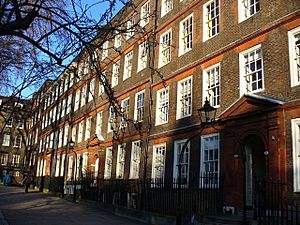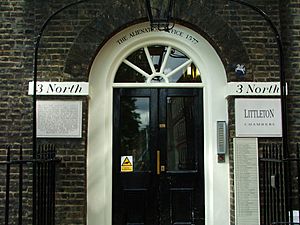King's Bench Walk, London facts for kids
King's Bench Walk is a street in a historic part of London called the Temple. It's mostly filled with offices where barristers (a type of lawyer) work. This area is very old and has a long connection to the law.
Contents
The History of King's Bench Walk
King's Bench Walk is part of the Inner Temple. This is one of four special places in London called the Inns of Court. The other three are Middle Temple, Lincoln's Inn and Gray's Inn. The whole Temple area gets its name from a group called the Knights Templar. They were a Christian military group formed a long time ago, in 1118 AD.
In 1162, the Knights Templar bought the land we now call Temple. They used it as their main base. One of the oldest buildings still standing is the Temple Church. It was officially opened in 1185. The Temple Bar gateway also gets its name from this old group. It stands outside the Royal Courts of Justice and marks the border between Westminster and the City of London.
The Knights Templar eventually broke up in 1307. In 1312, the Pope officially ended their order. The land then went to another group, the Knights Hospitaller. During the 1300s, while the Hospitallers owned the Temple, two law schools started there. By 1388, these two groups became known as Inner Temple and Middle Temple. Since then, the Temple has been a very important place for lawyers and the legal profession.
Buildings and Their Stories
King's Bench Walk is named after the Office of the King's Bench. This office was first located on the street in 1621. Buildings have stood on King's Bench Walk since before 1548. Sadly, these buildings were destroyed in the Great Fire of London in 1666. The new buildings that replaced them were also burned down in another London fire in 1677.
Before these fires, the buildings at 4, 5, and 6 King's Bench Walk were known as King's Bench Buildings. Number 4 King's Bench Walk is across from the Inner Temple Library. Like other buildings on the street, it was rebuilt in 1678 after the 1677 fire.
You can see a special message carved into the building. It says:
"Conflagratam Ano 1677. Fabricatam Ano 1678. Richardo Powell Armiger Thesaurar"
This means "Burned in the Year 1677. Built in the Year 1678. Richard Powell, Esquire, Treasurer." This message is on four separate tiles above the arched doorway of number four. It also mentions Richard Powell was the treasurer of the Inner Temple when the building was rebuilt.
The archway is thought to be designed by Sir Christopher Wren. He was a very famous English architect. He is best known for designing St Paul's Cathedral in London. You can see more of his work on Fleet Street, like St Brides Church. It has the tallest steeple designed by Wren. Luckily, 4 King's Bench Walk was one of the few buildings in the Inner Temple that was not destroyed during World War II.
Someone named "Thos Dainand" scratched their name and the date "March 19, 1793" into one of the windowpanes. On January 4, 1950, 4 King's Bench Walk became a Grade I listed building. This means it is a very important historical building.
Numbers 12 and 13 King's Bench Walk are Grade II listed buildings. They were first built in the early 1800s. They had a simple style and were covered in Bath stone. They were destroyed during the Blitz in World War II but were rebuilt to look exactly the same.
Who Works Here?
Many different groups of barristers have had offices at 4 King's Bench Walk over the years. Today, only one group, 4 King's Bench Walk Chambers (known as 4KBW), works there. It is led by Gavin Holme. 4KBW is known for having barristers who are experts in many different areas of law. There is also a law firm called Preiskel Solicitors, who specialize in media and phone company law. A private home is on the top floor.
Some famous people who used to live at number four include Sir Harold George Nicolson. He was a diplomat, writer, and politician. Another was Sir Ralph Norman Angell, who was a journalist, writer, and Member of Parliament.
12 King's Bench Walk is home to the offices of Paul Russell QC, known as 12KBW. In the early 1900s, Montague Berryman QC led 12KBW. Gerald Gardiner, Baron Gardiner and Peter Rawlinson, Baron Rawlinson of Ewell also used to work here. Today, 12KBW uses both number 12 and number 13 King's Bench Walk. They are a top group for cases involving injuries, work-related illnesses, and travel law.
King's Bench Walk in Books
King's Bench Walk is mentioned in many novels, including Charles Dickens' famous book A Tale of Two Cities:
"After a few dull efforts to get to sleep again, which the man dexterously combated by stirring the fire continuously for five minutes, he got up, tossed his hat on, and walked out. He turned into the Temple, and, having revived himself by twice pacing the pavements of King's Bench-walk and Paper-buildings, turned into the Stryver chambers."
It also appears in chapter one of The Red Thumb Mark by R. Austin Freeman. This book is part of a series of detective stories about a special investigator named Dr. Thorndyke:
"Conflagratam Ano 1677. Fabricatam Ano 1698. Richardo Powell Armiger Thesaurar." The words, set in four panels, which formed a frieze beneath the pediment of a fine brick portico, summarised the history of one of the tall houses at the upper end of King's Bench Walk and as I, somewhat absent mindedly, read over the inscription, my attention was divided between admiration of the exquisitely finished carved brickwork and the quiet dignity of the building, and an effort to reconstitute the dead and gone Richard Powell, and the stirring times in which he played his part."
—Richard Austin Freeman, The Red Thumb Mark (1907), Chapter I
In The Squire of Alsatia, Thomas Shadwell talks about King's Bench Walk when it was still called King's Bench Buildings:
"I have been at your brother's house, and they say he is come to some lawyer's chamber in the King's Bench Buildings"
—Thomas Shadwell, The Squire of Alsatia (1688)




